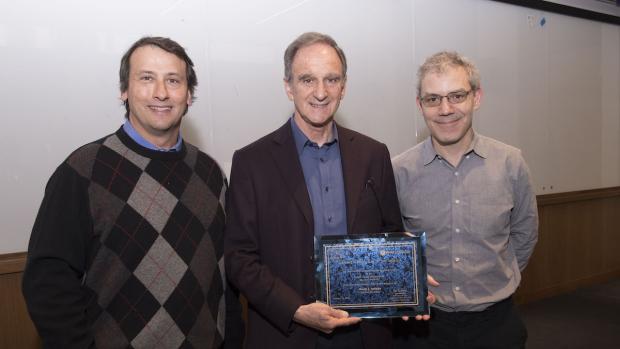Co-Inventor of Public Key Cryptography, Turing Award Winner, Alum
Martin Hellman (’66) Gives 2018 Ernst Weber Lecture at NYU Tandon

Theodore Rappaport, Director, NYU WIRELESS and David Lee/Ernst Weber Professor of Electrical Engineering; Martin Hellman, Professor Emeritus of Electrical Engineering at Stanford University; Ivan Selesnick, Department Chair and Professor of Electrical & Computer Engineering
Public key cryptography (PKC) — a system in which a public key that can be freely shared is used to encrypt content, while a separate, private one, known only to its owner, is used for decryption — is often described as revolutionary. Martin Hellman, who invented the system with two of his students at Stanford University, says that while he is gratified by that description, the process by which he and his co-creators came up with PKC can also be considered evolutionary rather than revolutionary.
Hellman made the quip while delivering the 2018 Ernst Weber Lecture at NYU Tandon, the latest in a prestigious annual series hosted by the Department of Electrical and Computer Engineering. (The event is named in honor of the pioneering electrical engineer and university administrator who helped turn what was then called the Polytechnic Institute of Brooklyn into one of the nation's foremost schools of engineering.)
Within the space of an hour, Hellman — who began his career in the late 1960s at IBM’s Thomas J. Watson Research Center, which had just launched a cryptographic research program — related the rollicking, drama-filled tale of PKC’s discovery, complete with battles with the National Security Agency (NSA), invocation of the International Traffic in Arms Regulations, lawyers, and threats of imprisonment.
In the mid-1970s, as Hellman described, the U.S. National Bureau of Standards (NBS), proposed a Data Encryption Standard (DES) to protect sensitive data. He and co-creator Whitfield Diffie realized that the 56-bit key size the NBS was proposing was inadequate, but the powers-that-be strenuously resisted. While never explicitly giving their reasons, a larger key size would allow foreign governments, criminals, and terrorists to hide their communications from the NSA. “What we had thought was a technical problem turned out to be political,” he explained.

As Diffie and Hellman prepared to go public with their battle, two high-level NSA employees visited them and tried to discourage them, arguing that they could cause grave harm to national security. “NSA was telling me the right thing was to be quiet, while my intellect told me the opposite, even from a purely national perspective,” Hellman recalled. “The U.S. was the world's most computerized nation, with the most to lose from insecure encryption.”
In late 1976 the two researchers proposed a generalized framework for a public key cryptosystem that included the novel idea of digital signatures, which encrypt documents with hard-to-duplicate digital codes, in the paper "New Directions in Cryptography," published in IEEE Transactions on Information Theory.
In mid-1977, an NSA employee wrote to the IEEE, claiming it was breaking the law by publishing Hellman’s papers. The employee somewhat convolutedly cited the International Traffic in Arms Regulations (ITAR), which, at the time, defined anything cryptographic as an implement of war, requiring an export license. Concerned, Hellman approached Stanford University’s General Counsel. The lawyer gave Hellman support by telling him that "the University would defray the reasonable costs of your defense,” but then warned: “nevertheless, there would always remain a risk to you personally of fine or imprisonment if the government prevailed in such a case."
Luckily, in 1978, NSA Director Adm. Bobby Inman expressed a willingness to talk, and something of a détente was reached between the researchers and the agency. Later, in the mid-1990s, Congress ordered a major study of national cryptographic policy that resulted in a significant loosening of the export restrictions on encryption products, set the stage for widespread availability of strong encryption in digital products, and generated new acceptance of Hellman’s work.
Surprising and delighting audience members who believed that they were in for only a technical discussion of PKC, Hellman closed his talk by discussing his own, personal evolution. The co-author, along with his wife, Dorothie, of a book entitled A New Map for Relationships: Creating True Love at Home and Peace on the Planet, Hellman describes how his journey as a scientist informed his marriage. “When Admiral Inman came to my office [in 1978], he told me he was meeting with me against the advice of all the other senior people at the Agency but saw no harm in talking. He was curious, not furious,” Hellman recalled. Applying that rhyming wisdom to his relationship with Dorothie has allowed him, he said, to go some 20 years without a serious marital spat. “Now in my 70s, I’m very different from that 30 year old who was constantly battling both the NSA and my wife,” he admitted. “Even though that hasn’t resulted in any awards, that is the accomplishment I’m most proud of.”





